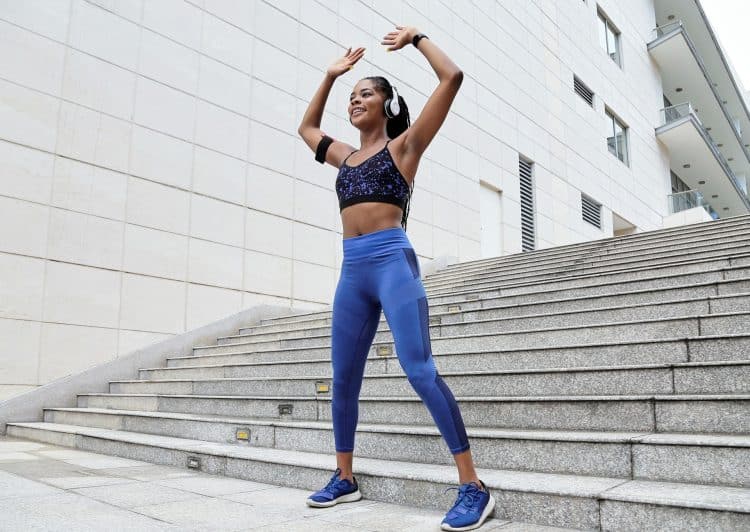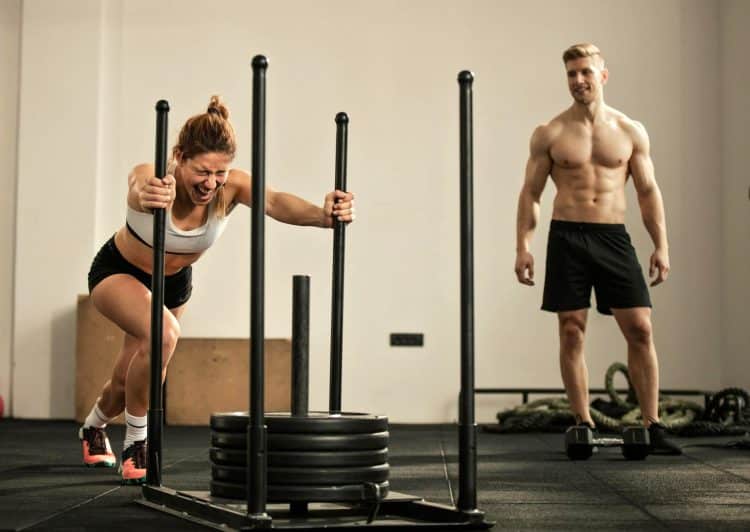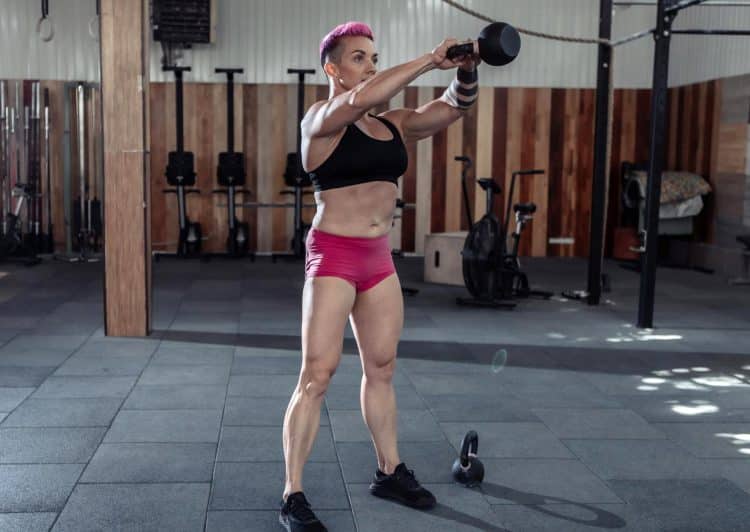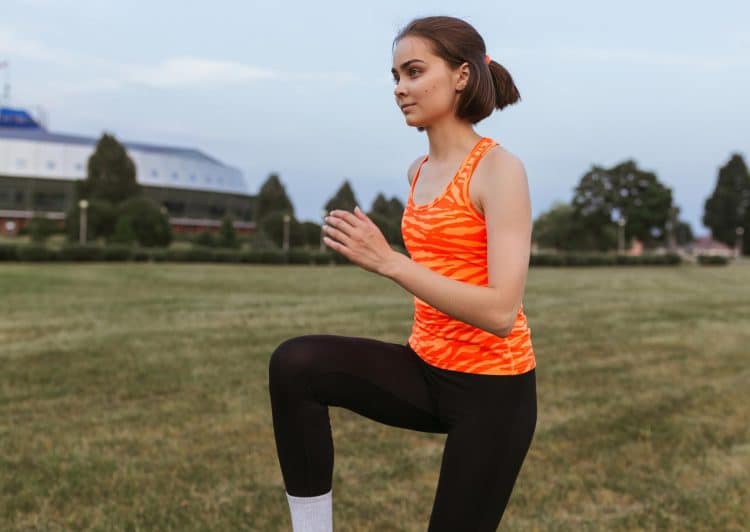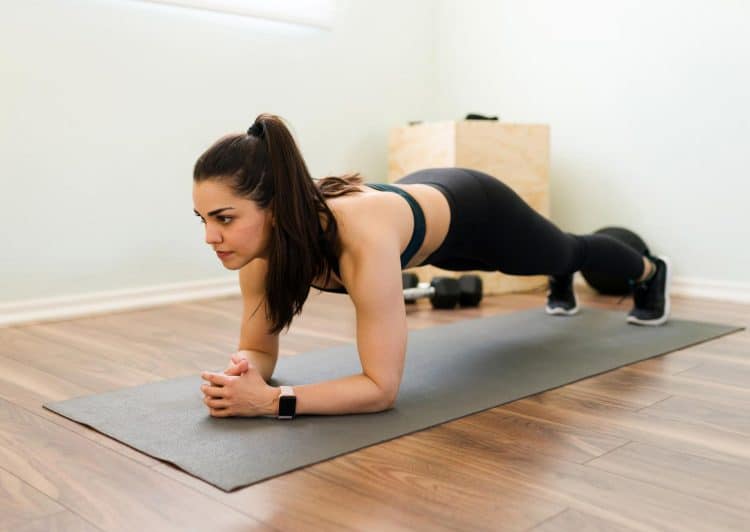High-intensity interval training, also known as HIIT workouts, is your best bet if you want to lose weight and tone your muscles. This training protocol involves alternating short periods of intense or explosive anaerobic exercise with brief recovery periods until the point of exhaustion.
A HIIT workout is an anaerobic activity as it involves short bouts of intense exercise at maximum or near maximal effort lasting anywhere from 10 to 60 seconds, followed immediately by a rest period of the same length. This cycle is usually repeated anywhere from 3 to 10 times, depending on your goals and workout regimen.
The maximal effort, duration, and short rest periods are some properties of HIIT workouts that separate them from conventional cardiovascular exercises (aerobic exercises).
Difference Between Aerobic and Anaerobic Exercises
During aerobic (cardio) exercises, your breathing and heart rate increase for a sustained period. In this type of training, your body uses oxygen as the main energy source. On the other hand, while performing anaerobic (HIIT) workouts, your body requires immediate energy and relies on stored energy sources rather than oxygen as fuel, breaking down glucose in the process.
However, you shouldn’t jump into HIIT workouts if you are a beginner. Build your cardiovascular conditioning and endurance before adding all-out HIIT workouts to your training regimen.
Notably, cardiovascular activities like running, cycling, and bodyweight exercises can also be used in HIIT workout sessions by modifying their training tempo and work-rest duration.
Level Up Your Fitness: Join our 💪 strong community in Fitness Volt Newsletter. Get daily inspiration, expert-backed workouts, nutrition tips, the latest in strength sports, and the support you need to reach your goals. Subscribe for free!
Ideal Length of a HIIT Workout
There is no set time standard for a HIIT workout. Your HIIT session’s duration will change depending on your current fitness level and goals. However, a HIIT workout should typically last under 30 minutes as it uses anaerobic energy. Furthermore, your training bouts should range between 20 to 45 seconds but not longer than 75 seconds as the aerobic system kicks in beyond this mark. [1]
Is HIIT Workout Good for Women?
HIIT is great for all genders. High-intensity interval training can help balance hormones, maintain bone density, and tone muscles in women, but more on it later.
Plus, since men are usually stronger than females, a specialized HIIT workout regimen can help women achieve better results than following a vanilla HIIT routine designed for males.
6 Best HIIT Workouts For Women
Here are the best high-intensity interval training circuits for ladies based on their experience levels. The workouts below are geared toward helping you lose weight and tone your muscles.
Pre-Requisites For an Effective HIIT Workout
Before we get into the nitty gritty of HIIT workouts for women, here are the things you should keep in mind before starting the training circuits:
- Time: The workouts laid out in this article should not last more than 30 minutes unless otherwise mentioned.
- Setup: Keep the required training tools like dumbbells, kettlebells, or resistance bands at hand before starting your circuit. Looking for the equipment mid-set can lower your training intensity.
- Rest: Make sure the rest duration between exercises is not longer than the length of your working set. You are allowed a 1-2 minute rest between circuits.
- Use a Stopwatch: Since most exercises in the HIIT workouts for women routine will be time-bound, it is imperative that you have a watch at hand.
So, without further ado, here are the six best HIIT workouts for women:
HIIT Workout For Women #1: Beginners (Bodyweight)
This entry-level HIIT workout is great for newbies who lack endurance and core strength.
HIIT Workout for Beginners Circuit Details:
- Rounds: 2
- Exercises: 7
- Working Set: 60 seconds
- Rest (between exercises): 30 seconds
- Rest (between rounds): 2 minutes
- Total Time: 23 minutes
Exercises:
- Jumping Jacks
- Banded Jumping Jacks
- Power Squat
- Jump Squat
- Sumo Squat
- Squat Twist
- Standing Crossover Crunch
Pro Tip: While performing exercises that involve jumping, jump as high as possible and try to achieve a soft landing to minimize the impact on your joints and tendons. Plus, although HIIT workouts involve performing a lot of reps, you shouldn’t use them as an excuse to perform exercises with a lousy form.
HIIT Workout For Women #2: Intermediate to Advanced (Bodyweight)
The HIIT workout for intermediate and advanced trainers raises the difficulty by a notch.
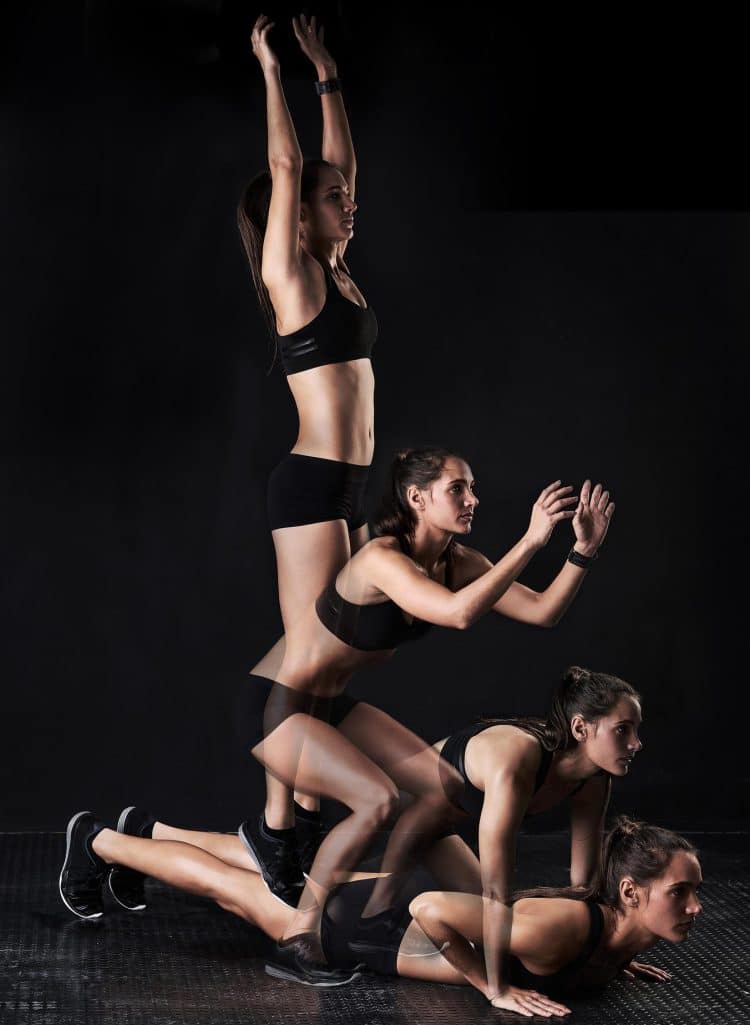
HIIT Workout for Intermediate to Advanced Trainers Circuit Details:
- Rounds: 3
- Exercises: 8
- Working Set: 45 seconds
- Rest (between exercises): 20 seconds
- Rest (between rounds): 1-minute
- Total Time: 32 minutes
Exercises:
Pro Tip: You could finish this 32-minute workout in half an hour by shortening your rest duration between exercises and circuits. Use this as a challenge as you get better at performing this circuit.
HIIT Workout For Women #3: Beginners (Resistance)
This HIIT workout for women involves the use of resistance. It will make the exercises harder and help improve your endurance and build a stronger core.
HIIT Workout for Beginners (Resistance) Circuit Details:
- Rounds: 2
- Exercises: 7
- Working Set: 60 seconds
- Rest (between exercises): 30 seconds
- Rest (between rounds): 2 minutes
- Total Time: 23 minutes
Exercises:
- Sled Push
- Battle Ropes
- Goblet Squat
- Resistance Band Lateral Walk
- Wall Ball
- Thrusters
- Russian Twist
Pro Tip: Feel free to use heavier weights as you progress through the circuits. While performing bodyweight and resistance exercises, contract your working muscles with every rep.
HIIT Workout For Women #4: Intermediate to Advanced (Resistance)
The advanced HIIT resistance workouts for women will have you running on fumes by the end. Jump into the next exercise as soon as possible, even if you still have some rest time to spare.
HIIT Workout for Intermediate to Advanced Trainers (Resistance) Circuit Details:
- Rounds: 2
- Exercises: 9
- Working Set: 45 seconds
- Rest (between exercises): 30 seconds
- Rest (between rounds): 2 minutes
- Total Time: 27 minutes
Exercises:
- Sled Push
- Sled Pull
- Kettlebell Swing
- Renegade Row
- Clean and Press
- Slam Ball
- Resistance Band Romanian Deadlift
- Flutter Kicks
- Plank
Pro Tip: You could use alternative exercises if you are dealing with an injury and are not comfortable performing some of the exercises mentioned in the circuits.
HIIT Workout For Women #5: Sprint (Distance)
Many people stay away from HIIT workouts because they think they’ll have to do bodyweight or resistance exercises. However, it is not the case. High-intensity interval training is a workout principle that can be applied to cardio training, which is great news for runners.
HIIT sprints are a great option for folks who like to take their workouts outdoors. This training technique does not require any specialized training equipment. A pair of running shoes and solid grit is all you need.
Given below are three HIIT sprinting workouts for women that will help you melt fat off your body.
Option 1: 10 x 50m Sprints
In this HIIT sprint workout, you’ll sprint for 50 meters, walk back to the starting line, sprint again for 50 meters, and repeat this eight more times.
Before starting your sprinting session, spend five minutes warming up by performing a static and dynamic stretching routine. Follow it up with a five-minute light jogging session before beginning the HIIT cardio routine.
Make sure you’re going all out while performing the 50m sprints. Also, do not fool around while returning to the starting line. Keep your rest time between sprints short by speed-walking to the starting point. This HIIT sprint routine should not last more than 20 minutes, including the warm-up session.
Option 2: 10 x 100m Sprints
As you gain experience and build endurance, you can graduate to 100m sprints.
Follow the same warm-up routine and method for the 100m sprints as the 50m sprints. Since you’ll be running a bigger distance, you might experience a drop in intensity while performing the 100m sprints. However, make sure you’re not leaving anything in the tank.
Even if you are an advanced lifter and can spend hours in the gym training, you shouldn’t try to outrun Usain Bolt by beginning your HIIT sprint routine with the 100m sprints. Build muscle and joint strength, stamina, and endurance by sticking to the 50m sprints for a few weeks before switching to 100m dashes.
You should not spend more than 30 minutes on this training regimen.
Option 3: 15-minute Sprints
The third option is perfect for people who like to save their HIIT workouts for after their strength training routines. You could perform this exercise on a treadmill or any other cardio machine.
In the 15-minute HIIT sprint routine, you’ll run at maximum intensity for a minute before switching to a walking speed for the next minute. You’ll repeat this cycle for 15 minutes.
As a rule of thumb, your intensity should be so high that you cannot make conversation during the high-intensity phase.
Since you’ll already be warmed up after your strength training routine, you do not need to follow a warm-up routine for the 15-minute post-workout HIIT sprints. However, we recommend a five-minute cool-down stretching routine after the HIIT session to flush lactic acid out of your muscles.
HIIT Workout For Women #6: Short and Intense (Under 5 minutes)
The five-minute HIIT workout is great for days when you sleep in and only have five minutes to complete a workout.
- Rounds: 1
- Exercises: 5
- Working Set: 40 seconds
- Rest (between exercises): 20 seconds
- Rest (between rounds): 0 minutes
- Total Time: 5 minutes
Exercises:
Level Up Your Fitness: Join our 💪 strong community in Fitness Volt Newsletter. Get daily inspiration, expert-backed workouts, nutrition tips, the latest in strength sports, and the support you need to reach your goals. Subscribe for free!
- Jog-in-place
- Walking High Knees
- Vertical Jump
- Jumping Jacks
- Burpee
The five-minute HIIT workout for women only has five exercises but will leave you begging for mercy by the time you are done with it.
Pro Tip: While the five-minute HIIT workout is a great place to start, it is not the most optimal for building muscle or losing fat. Try incorporating at least two of these five-minute HIIT bouts into your day.
Benefits of HIIT Workouts For Women
Adding HIIT workouts to your workout regimen entails the following advantages:
1. Promotes Bone Metabolism
A study showed that eight weeks of HIIT workouts significantly improves bone metabolism in women. Bone metabolism is the constant production and degradation of bone tissue necessary for maintenance and repair. [2]
2. Helps Tone the Body
Regular HIIT workouts can lead to weight loss and muscle and strength gains, which can help tone your body. Bodyweight HIIT workouts are incredibly effective and great for folks who do not like resistance training.
3. Aids Weight Loss
Weight loss is one of the primary reasons why many people perform HIIT training. A study shows that HIIT workouts may be most effective for fat loss in overweight or obese people. [3]
4. Promotes Muscle Growth
Research shows that HIIT training can help build muscle mass. However, the muscle gain is primarily in the muscles used the most, like the legs. [4][5]
5. Improves Cardiovascular Health
Although they are an anaerobic training program, HIIT workouts can improve your muscles’ oxygen consumption.
A study concluded that eight weeks of exercising on a stationary bike using traditional exercise or HIIT increased oxygen consumption by about 25%. [6][7]
6. Beneficial For Diabetic Patients
Research has shown that high-intensity interval training can promote improvements in glucose control and cardiovascular health in individuals with type 2 diabetes.[8]
7. Promotes Quality Sleep
Research suggests that engaging in HIIT workouts at least three times a week can improve your sleep quality and be a promising alternative for sleep disorder treatment. [9]
8. Efficient at Burning Calories
A study suggests HIIT workouts are more effective than cardio or weight training at burning calories, making it the best weight loss solution when you’re short on time. [10]
9. Perfect For Women Who Cannot Make Time For the Gym
Since most HIIT workouts are time-efficient and last less than 30 minutes, they are a great fit for people with packed schedules who cannot make time to hit the gym. HIIT sessions can be done in the comfort of your home.
10. Boosts Metabolism
HIIT workouts help you burn calories long after your training session is over by spiking your metabolic rate. A study found that HIIT workouts are more effective than jogging or weight training at increasing your metabolism after exercise. [11]
How Often Should I Do HIIT Workout?
The National Academy of Sports Medicine recommends doing HIIT workouts two to three times a week with at least 48 hours between sessions. Overshooting this number can lead to higher chances of injuries.
Even though HIIT workouts have several benefits, you shouldn’t use them as excuses to ditch LISS (low-intensity steady state) training. A 15-30 minute jog or swim can help you build your endurance levels, which can improve your performance in HIIT workouts.
How To Incorporate HIIT Training in Your Training Regimen?
As mentioned above, you should not perform more than three HIIT workouts a week. However, this number is suggested when you perform 30-minute-long HIIT workout sessions. You could make 15-minute post-resistance training HIIT workouts [#5 (option #3)] or five-minute HIIT workouts [#6] a part of your daily routine.
Here is a sample HIIT workout split for women:
- Monday: Upper Body
- Tuesday: Lower Body
- Wednesday: 30-minute HIIT
- Thursday: Upper Body
- Friday: Lower Body
- Saturday: 30-minute HIIT
- Sunday: Active Rest [5-minute HIIT workout optional]
Dos and Donts of HIIT Workouts for Women
Here are a few things you should know before starting your high-intensity interval training journey:
Dos of HIIT Workout
1. Take it Slow at the Beginning
Although HIIT includes performing sprints, your training approach should be akin to a marathon. Do not rush into advanced HIIT routines. Build your endurance and stamina before taking the leap, or you’ll risk getting injured.
2. Set Realistic Goals
Many exercisers quit training before they achieve their objectives because they set unrealistic goals. You should give yourself at least two to three months to start seeing results, especially if you’re a beginner.
3. Make a Schedule and Stick to it
Winston Churchill hit the nail on its head when he said, “He who fails to plan is planning to fail.” To succeed in your transformation journey, you should follow a structured HIIT program and stick to it.
4. Use a Timer for Exercises
Using a timer is a must while performing HIIT workouts. You could use the stopwatch app on your phone, a smartwatch, or a wall clock.
5. Keep Track of Your Progress
To ensure you’re headed in the right direction, keep a tab on your progress and make necessary changes when you do not see the needle budge in the right direction.
6. Stay Hydrated During the Training Session
HIIT workouts can be taxing. Performing HIIT bouts in hot and humid conditions can cause dehydration. Use the rest times between exercises to sip on water.
Don’ts of HIIT Workout
1. Forget to Warm Up
Heading into a HIIT bout as soon as you enter the gym is a sure-shot way of getting injured. You should spend at least 10 minutes warming up before starting your high-intensity interval training routine.
2. Overtrain
You should not engage in another HIIT session if you feel tired and sore even 48 hours after your last HIIT routine. Keep your HIIT workouts 30 minutes or shorter to ensure you are not overtraining.
3. Compromise Your Nutrition and Sleep
Follow a proper diet and recovery program to recuperate after your workouts. Use our convenient online calorie calculator to determine your ideal macronutrient breakdown. Plus, make sure you are sleeping seven to eight hours every night.
How to Create a HIIT Workout
Here is how to create your personalized HIIT workout program:
1. Select Exercises as Per Your Experience Level
The first step should be to assess your experience level and choose exercises you can perform with the correct form for the stipulated time or reps.
2. Pick a Goal
A HIIT workout routine can focus on helping you lose fat, build strength and muscle mass, or improve your mobility.
Club 5-10 different exercises depending on your goal while ensuring your total training time stays below 30 minutes.
3. Choose Exercises You Can Do in the Same Place
While designing a HIIT circuit, you should put together exercises that can be done using minimal or similar equipment in the same place. Switching equipment or places can take time and lower your training intensity.
4. Alternate Between Easy and Hard Exercises
Performing hard exercises like the burpees, clean and press, and box jumps can be too taxing on your system. Alternate between easy and hard exercises so you have time to breathe between hardcore exercises.
Related: How to Design the Perfect Training Plan
FAQs
How to know if a HIIT workout is right for me?
You should always choose a workout program based on your experience level. If an exercise routine has exercises that you’ve never done before, you should perfect your form on the movements before adding them to your HIIT routine.
By When Should I Expect Good Results?
If you are new to HIIT training, you should give it at least 2-3 months before expecting significant physique improvements.
Can I fit HIIT into my routine workout?
You could fit a 5-minute or 15-minute treadmill HIIT workout into your routine resistance training workout. However, you should not perform a 30-minute HIIT bout and a 45-minute resistance training routine in the same training session.
Should I eat before the HIIT workout?
Depending on your diet program, you could eat 30-45 minutes before your HIIT workout.
Should I eat after the HIIT workout?
Yes, you could eat a high-protein meal after your HIIT workout to refuel your muscles.
Why am I gaining weight after a HIIT workout?
Weight gain is the result of staying in a calorie surplus. You should re-analyze your calorie intake and focus on getting into a calorie deficit, meaning you should burn more calories than you consume in a day.
Can I do a HIIT workout during my period?
Contrary to what many women think, your periods might be the best time to perform HIIT workouts. During periods, estrogen and progesterone levels drop due to which women can access glycogen easily. On the other hand, women experience a slow fat breakdown during high-estrogen periods. However, you should listen to your body and take a break if your body needs it.
Wrapping Up
HIIT workouts are incredibly effective at shedding body fat and building muscle mass. Plus, they can help improve oxygen consumption, boost metabolic rate, and reduce blood pressure, heart rate, and blood sugar levels.
The six HIIT workouts for women mentioned in this article will help women at different experience levels get the best bang for their buck. Stick to your guns and give the workouts at least eight weeks to work their magic. Best of luck!
References
- Gastin, P.B. Energy System Interaction and Relative Contribution During Maximal Exercise. Sports Med 31, 725–741 (2001). https://doi.org/10.2165/00007256-200131100-00003
- Lu M, Li M, Yi L, Li F, Feng L, Ji T, Zang Y, Qiu J. Effects of 8-week High-Intensity Interval Training and Moderate-Intensity Continuous Training on Bone Metabolism in Sedentary Young Females. J Exerc Sci Fit. 2022 Apr;20(2):77-83. doi: 10.1016/j.jesf.2022.01.001. Epub 2022 Jan 5. PMID: 35096081; PMCID: PMC8762074.
- Martins C, Kazakova I, Ludviksen M, Mehus I, Wisloff U, Kulseng B, Morgan L, King N. High-Intensity Interval Training and Isocaloric Moderate-Intensity Continuous Training Result in Similar Improvements in Body Composition and Fitness in Obese Individuals. Int J Sport Nutr Exerc Metab. 2016 Jun;26(3):197-204. doi: 10.1123/ijsnem.2015-0078. Epub 2015 Oct 19. PMID: 26479856.
- Naimo MA, de Souza EO, Wilson JM, Carpenter AL, Gilchrist P, Lowery RP, Averbuch B, White TM, Joy J. High-intensity interval training has positive effects on performance in ice hockey players. Int J Sports Med. 2015 Jan;36(1):61-6. doi: 10.1055/s-0034-1382054. Epub 2014 Oct 20. PMID: 25329432.
- Martins C, Kazakova I, Ludviksen M, Mehus I, Wisloff U, Kulseng B, Morgan L, King N. High-Intensity Interval Training and Isocaloric Moderate-Intensity Continuous Training Result in Similar Improvements in Body Composition and Fitness in Obese Individuals. Int J Sport Nutr Exerc Metab. 2016 Jun;26(3):197-204. doi: 10.1123/ijsnem.2015-0078. Epub 2015 Oct 19. PMID: 26479856.
- Hwang CL, Yoo JK, Kim HK, Hwang MH, Handberg EM, Petersen JW, Christou DD. Novel all-extremity high-intensity interval training improves aerobic fitness, cardiac function and insulin resistance in healthy older adults. Exp Gerontol. 2016 Sep;82:112-9. doi: 10.1016/j.exger.2016.06.009. Epub 2016 Jun 21. PMID: 27346646; PMCID: PMC4975154.
- Skutnik BC, Smith JR, Johnson AM, Kurti SP, Harms CA. The Effect of Low Volume Interval Training on Resting Blood Pressure in Pre-hypertensive Subjects: A Preliminary Study. Phys Sportsmed. 2016;44(2):177-83. doi: 10.1080/00913847.2016.1159501. Epub 2016 Mar 17. PMID: 26918846.
- Francois ME, Little JP. Effectiveness and safety of high-intensity interval training in patients with type 2 diabetes. Diabetes Spectr. 2015 Jan;28(1):39-44. doi: 10.2337/diaspect.28.1.39. PMID: 25717277; PMCID: PMC4334091.
- Min L, Wang D, You Y, Fu Y, Ma X. Effects of High-Intensity Interval Training on Sleep: A Systematic Review and Meta-Analysis. Int J Environ Res Public Health. 2021 Oct 19;18(20):10973. doi: 10.3390/ijerph182010973. PMID: 34682718; PMCID: PMC8535574.
- Wingfield HL, Smith-Ryan AE, Melvin MN, Roelofs EJ, Trexler ET, Hackney AC, Weaver MA, Ryan ED. The acute effect of exercise modality and nutrition manipulations on post-exercise resting energy expenditure and respiratory exchange ratio in women: a randomized trial. Sports Med Open. 2015 Dec;1(1):11. doi: 10.1186/s40798-015-0010-3. Epub 2015 Jun 5. PMID: 27747847.
- Falcone PH, Tai CY, Carson LR, Joy JM, Mosman MM, McCann TR, Crona KP, Kim MP, Moon JR. Caloric expenditure of aerobic, resistance, or combined high-intensity interval training using a hydraulic resistance system in healthy men. J Strength Cond Res. 2015 Mar;29(3):779-85. doi: 10.1519/JSC.0000000000000661. PMID: 25162652.


